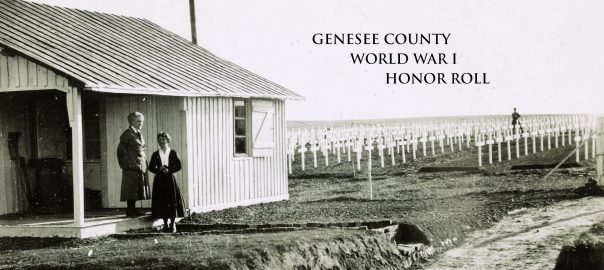Private, Co K, 60th Infantry, 5th Division.
Killed in action near Cunel, France, October 12, 1918. Age 31.
Town: Oakfield
Burial: Meuse-Argonne American Cemetery, Plot F Row 22 Grave 20, Romagne, France
Note: Philip Rocket was an Italian immigrant born on August 15, 1887. His draft registration card gives his birthplace as “Radusa, Syracusa, Italy,” while his NYSS says “Raduca, Italy.” Neither town name appears on maps today. It’s possible that both were misspellings of Ragusa, a city near Syracusa province, both in southern Sicily.
Research of federal and New York state censuses from the time, as well as immigration records, failed to turn up a Philip Rocket. The name is likely to have been an Americanization of the man’s original Italian name, which evidence from immigration and Burial Case File documents suggests may have been Filippo Rocchetto.
Several documents in Rocket’s Burial Case File identify his mother as Mrs. Vincenza Rossitto and his father as Rocchetto Vincenzo (given names often followed surnames), both of Valguarnera, Italy, in southern Sicily. Other documents in the file mention a cousin, Anthony Mancuso or Mancussa, at a Central Park Avenue, Rochester, New York, address. Ellis Island immigration records show a Filippo Rocchetto, age 28, of Valguarnera, Sicily, birthplace Raddusa, arriving at the Port of New York aboard the SS Giuseppe Verdi from Palermo, Italy, on November 20, 1915. Under “name and address of nearest relative . . . whence alien came” is listed, “Father, Rocchetto Vincenzo, Valguarnera.” The name below Filippo Rocchetto’s on the ship’s manifest, presumably his companion, is Antonino Mancuso, also of Valguarnera. Both men are shown to be traveling to stay with a cousin whose address is Central Park Avenue in Rochester, New York. Interestingly, both men also are listed as “Non Alien” claiming to be citizens and are shown to have lived in the United States previously; for Filippo, from 1907 to 1915. A second Ellis Island immigration record shows a Filippo Rocchetto, age 20, of Valguarnera arriving in New York, in the United States for the first time, in July 1908 (rather than 1907); much of the record is difficult to read but the father’s first name is discernible as Vincenzo.
It seems likely, but is uncertain, that both immigration records refer to the same Filippo Rocchetto. It also seems likely, despite some discrepancies (for example, Rocket is listed as an alien on his 1917 draft registration card), that Filippo Rocchetto and Philip Rocket were one and the same person. Lacking conclusive evidence, however, and because all official military documents refer to the soldier as Philip Rocket, that is the name used here.
Like many Italian immigrants living in Oakfield (Genesee County), New York, at the time, Philip Rocket was employed as a miner for the town’s United States Gypsum Company. He registered for the draft on June 5, 1917—the day that all males nationwide between the ages of 21 and 30 were required to register at their county draft boards. Drawings held in Washington, DC, that July determined the order in which registered men would be called before their local boards for examination for military service.
For uncertain reasons (perhaps language), Rocket initially encountered trouble with the draft board. An article in the November 22, 1917 Batavia Daily News reported that Philip Rocket of Oakfield had been charged with being a deserter from the Army for failure to report for military duty. A subsequent article published in the December 24, 1917 Batavia Daily News reported that Rocket had been arrested in Oakfield as a deserter for failure to appear for examination and had “seemed considerably surprised at being taken into custody.” The article said that he had been working in Rochester after leaving Oakfield, and had returned to the town to “settle up some business at the gypsum mill where he was employed at the time he was drafted.” The man had been placed in the Batavia jail.
Though it’s impossible to determine without additional information, Rocket’s case may have been one of simple miscommunication. At the time, any man who failed to appear when called for physical examination was considered enlisted by the Army and could be arrested as being a deserter. On July 21, 1917, the Batavia Daily News published a partial, preliminary list of the names of the county’s draft registrants in the order in which they had been drawn the day before in the national lottery. Rocket was not among the first 1500 names listed in the article, making it unlikely that he would be called in the near future; only the first 500, in fact, were expected to be called initially. However, less than a week later, on July 27, when the Batavia Daily News published a final, official list, Rocket was among those whose positions had changed. He had moved up to 192nd in order, putting him among the first several groups to be called. A couple of weeks later, in a August 9, 1917 Batavia Daily News article, Philip Rocket of Oakfield was listed among several men who had failed to appear for examination. It is possible that he simply didn’t know that his draft-order status had changed.
Regardless, apparently Rocket’s charge of desertion was quickly dismissed. According to his NYSS, he was inducted into the Army at Batavia on December 26, 1917 (two days after his arrest) and assigned to the 153rd Depot Brigade, part of the 78th Division at Camp Dix, New Jersey. On February 23, 1918, Private Philip Rocket was transferred from Camp Dix to the 5th Division’s 60th Infantry regiment, which left for France that April.
On the day Private Rocket was killed, during the launch of the Fourth Phase of the Meuse-Argonne offensive, the 5th Division replaced the battered 80th Division on the stubbornly defended front near Cunel. Around 6 a.m. the 60th Infantry’s 3rd Battalion, including Rocket’s Company K, advanced up a narrow-gauge railway cut east of Cunel and met fierce resistance from numerous machine-gun nests in and around the town. Intense shelling from enemy artillery on the heights east of the Meuse also claimed many casualties in the battalion during the day’s fighting.
A searcher’s report in Private Rocket’s Burial Case File quotes Private John Dilwo, also of Company K, 60th Infantry: “We were in the same shell hole before going over the top; he was in skirmish line when the company went over the top. October 12th 1918, at Cunel and has never been seen since.” The report also notes: “Carried on Company records as ‘missing in action.’ No burial records in the Company.”
Eventually Rocket’s remains were located and interred at the Meuse-Argonne American Cemetery in Romagne, France. On two documents in his Burial Case File, one from 1920 and the other 1921, the cause of death listed has been crossed out from “missing in action” or “now presumed to be dead” and changed to killed in action.
– – – – –
—— [CLICK ON DOCUMENTS TO OPEN FULL VIEW IN SEPARATE TAB] ——
– – – – –
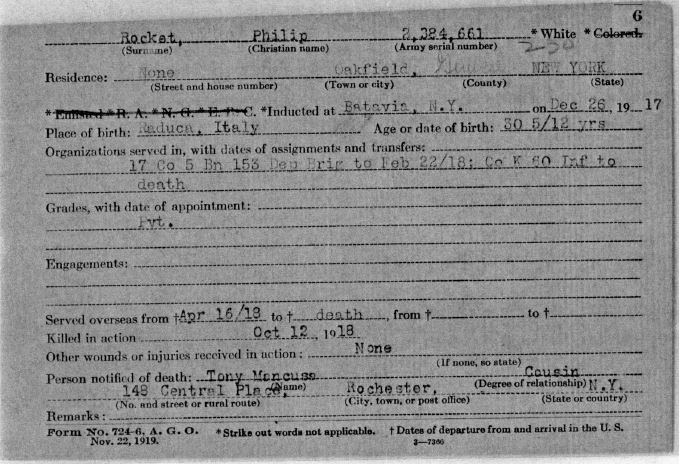 Source: New York Service Summary from Abstracts of World War I Military Service, 1917-1919, NY State Archives, Albany, New York
Source: New York Service Summary from Abstracts of World War I Military Service, 1917-1919, NY State Archives, Albany, New York
– – – – –
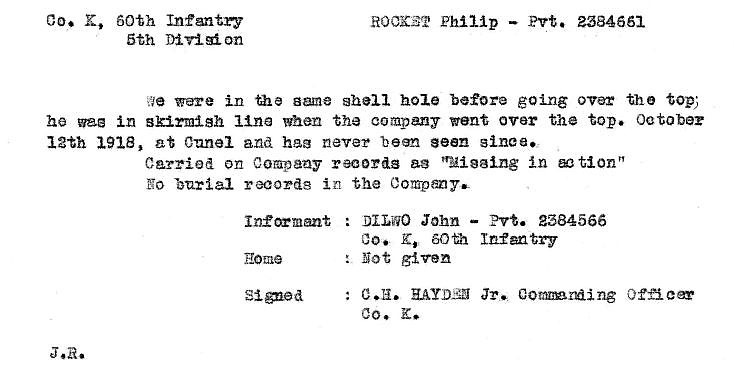 Source: Burial Case Files, Records of the Office of the Quartermaster General, Record Group 92, National Archives — St Louis, Missouri
Source: Burial Case Files, Records of the Office of the Quartermaster General, Record Group 92, National Archives — St Louis, Missouri
– – – – –
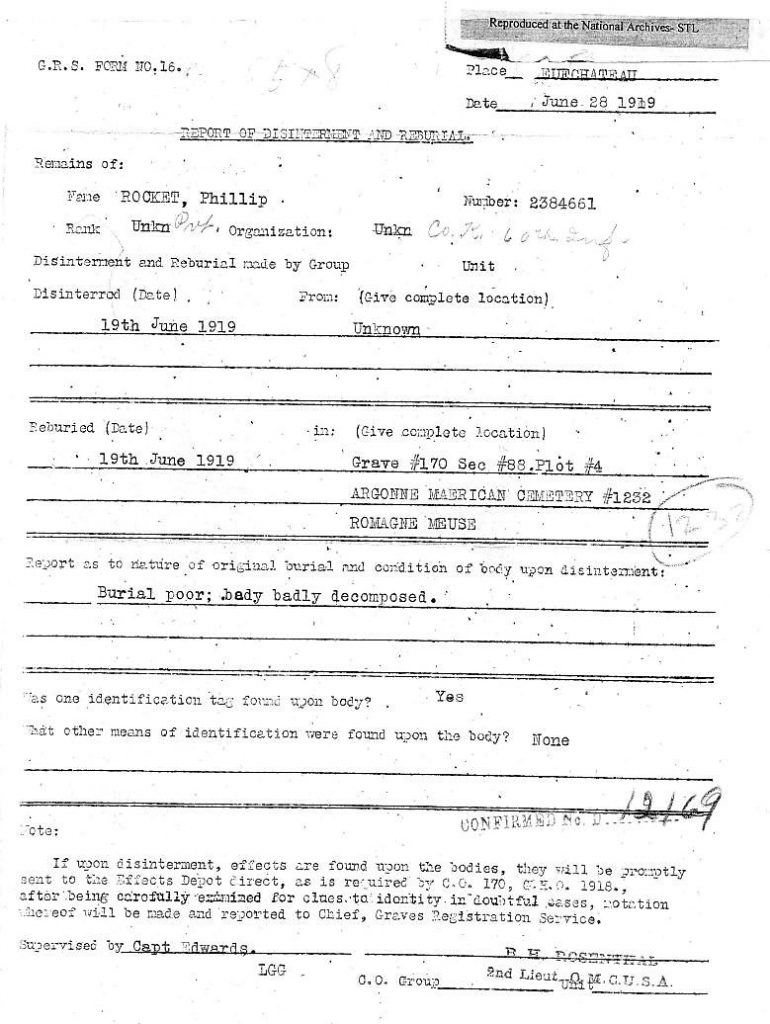 Source: Burial Case Files, Records of the Office of the Quartermaster General, Record Group 92, National Archives — St Louis, Missouri
Source: Burial Case Files, Records of the Office of the Quartermaster General, Record Group 92, National Archives — St Louis, Missouri
– – – – –
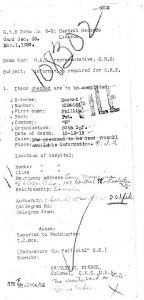 Source: Burial Case Files, Records of the Office of the Quartermaster General, Record Group 92, National Archives — St Louis, Missouri
Source: Burial Case Files, Records of the Office of the Quartermaster General, Record Group 92, National Archives — St Louis, Missouri
– – – – –
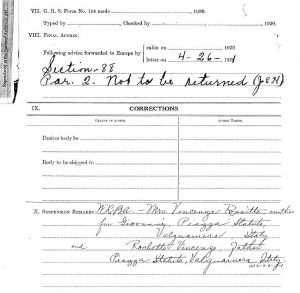 Source: Burial Case Files, Records of the Office of the Quartermaster General, Record Group 92, National Archives — St Louis, Missouri
Source: Burial Case Files, Records of the Office of the Quartermaster General, Record Group 92, National Archives — St Louis, Missouri
– – – – –
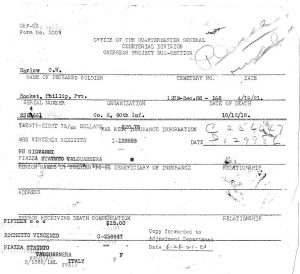 Source: Burial Case Files, Records of the Office of the Quartermaster General, Record Group 92, National Archives — St Louis, Missouri
Source: Burial Case Files, Records of the Office of the Quartermaster General, Record Group 92, National Archives — St Louis, Missouri
– – – – –
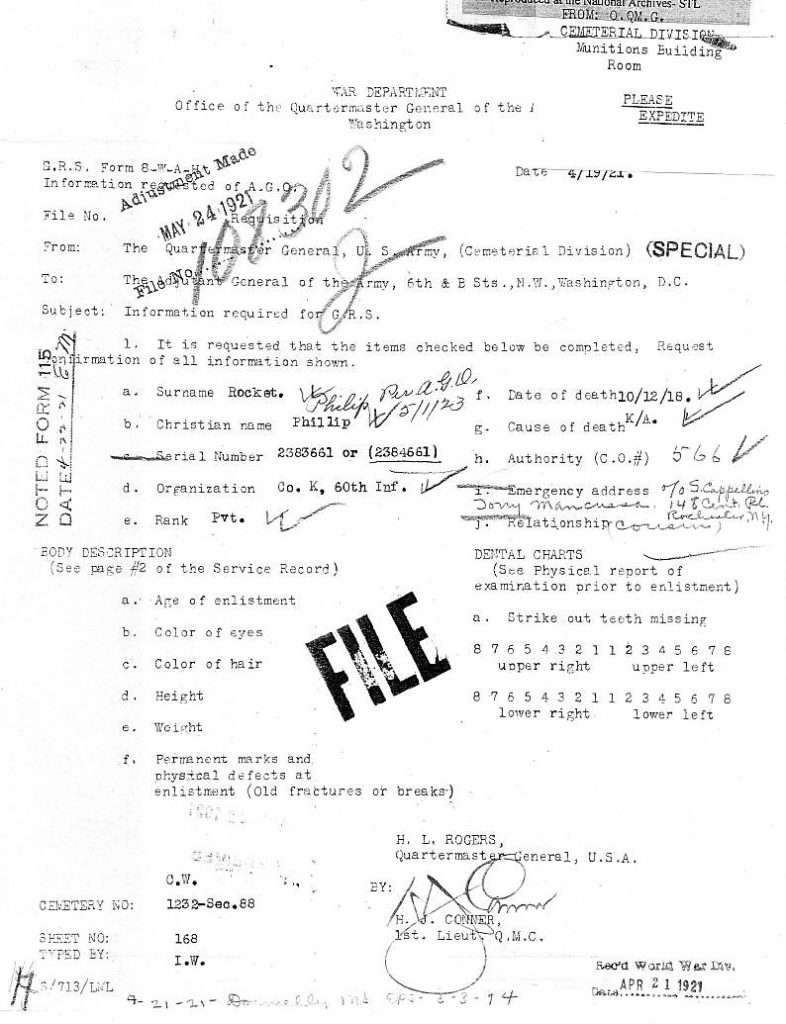 Source: Burial Case Files, Records of the Office of the Quartermaster General, Record Group 92, National Archives — St Louis, Missouri
Source: Burial Case Files, Records of the Office of the Quartermaster General, Record Group 92, National Archives — St Louis, Missouri
– – – – –
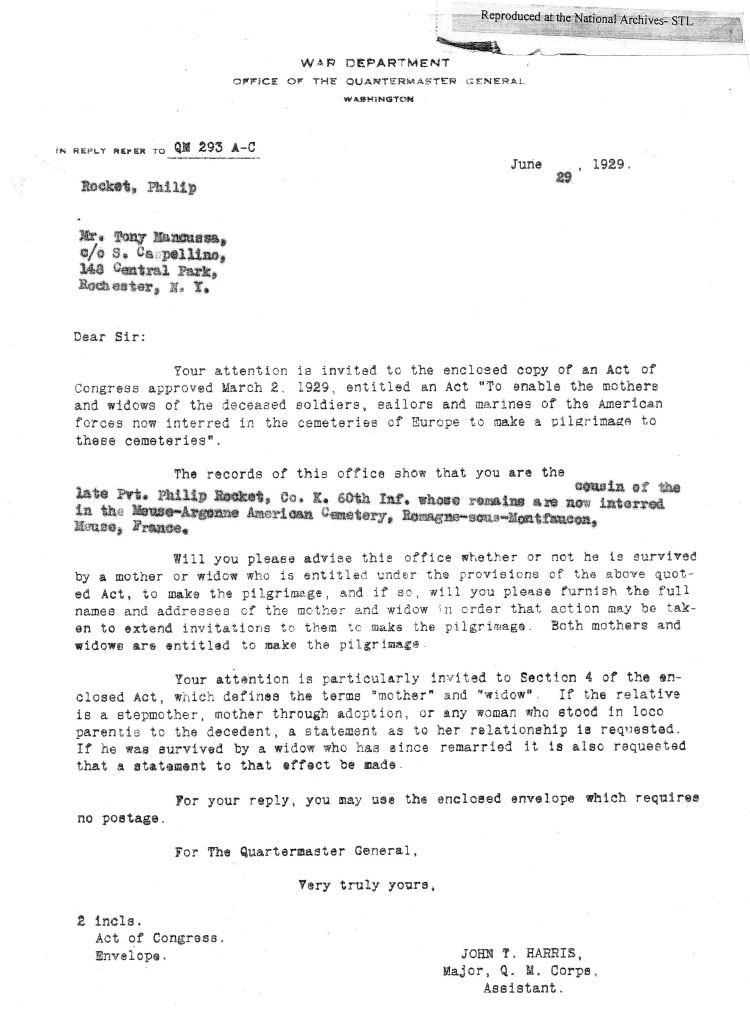 Source: Burial Case Files, Records of the Office of the Quartermaster General, Record Group 92, National Archives — St Louis, Missouri
Source: Burial Case Files, Records of the Office of the Quartermaster General, Record Group 92, National Archives — St Louis, Missouri
– – – – –
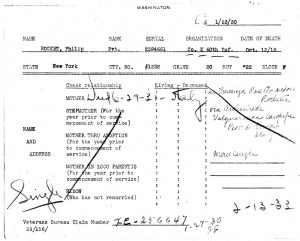 Source: Burial Case Files, Records of the Office of the Quartermaster General, Record Group 92, National Archives — St Louis, Missouri
Source: Burial Case Files, Records of the Office of the Quartermaster General, Record Group 92, National Archives — St Louis, Missouri
– – – – –
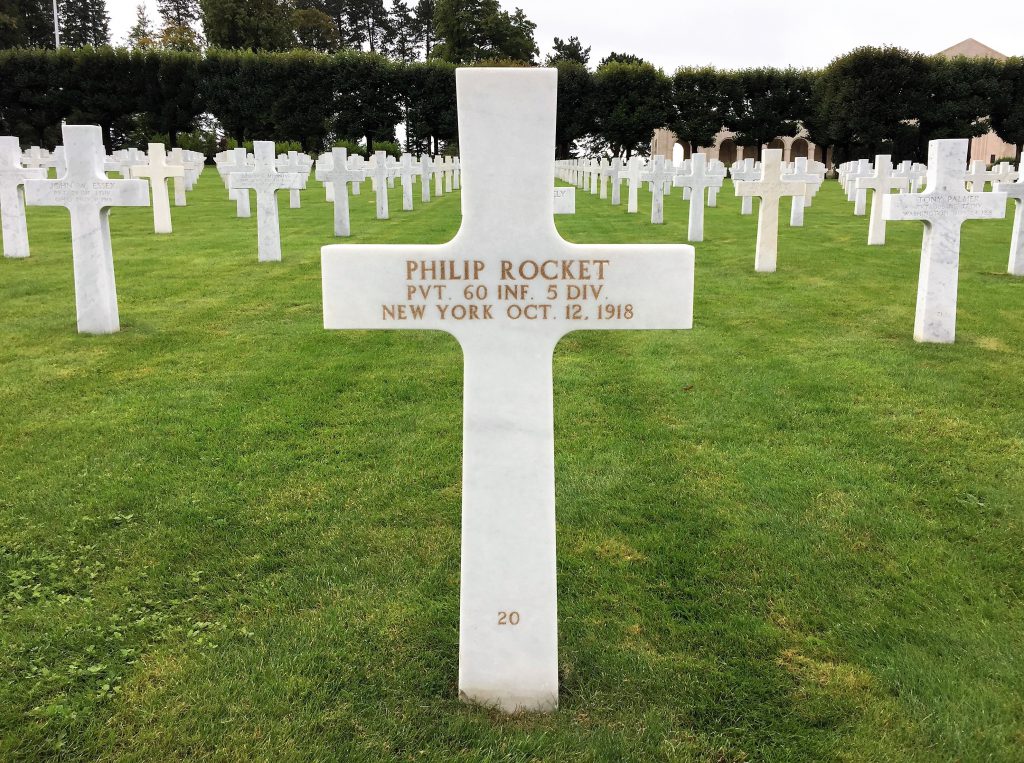 Philip Rocket headstone, Meuse-Argonne American Cemetery, Plot F Row 22 Grave 20, Romagne, France
Philip Rocket headstone, Meuse-Argonne American Cemetery, Plot F Row 22 Grave 20, Romagne, France
– – – – –
Philip Rocket Sources:
– County Lists 2, 3
– Jul 21, 1917 BD p1 c6-7, p6 c4
– Jul 21, 1917 BD p2 c1-7, p4 c5-7, p4 c1-7 (Rocket c6)
– Jul 27, 1917 BD p1 c6-7, p2 c1-3 (Rocket c2)
– Aug 9, 1917 p1 c6-7, p5 c3
– Nov 22, 1917 BD p8 c1
– Dec 24, 1917 BD p1 c5
– “List or Manifest of Alien Passengers for the United States Immigration Officer at Port of Arrival,” SS Nord-America arriving in New York from Palermo 24 July 1908, pages 361-362, list 9, line # 0022, Filippo Rocchetto, age 20, accessed online at http://www.libertyellisfoundation.org/passenger
– “List or Manifest of Alien Passengers for the United States Immigration Officer at Port of Arrival,” SS Giuseppe Verde arriving in New York from Palermo 20 Nov 1915, pages 803-804, list 107, line # 0026, Filippo Rocchetto, age 28, accessed online at http://www.libertyellisfoundation.org/ passenger
– NYSS
– Roll of Honor (NY State), p 65
– WWI database, American Battle Monuments Commission website (www.abmc.gov/search/wwi.php)
– World War I Draft Registration Cards, 1917-1918 (Ancestry.com)
– 5th Division, Summary of Operations in the World War, pp 27-29
– The Official History of the Fifth Division U.S.A., pp 135-39, p 354
– United States Army in the World War 1917-1919 (Vol. 9), pp 215-260
– BCF
– – – – –
Click for Key to Source Abbreviations. See the Bibliography for complete title, author, and publisher information, with links to online access when available.
